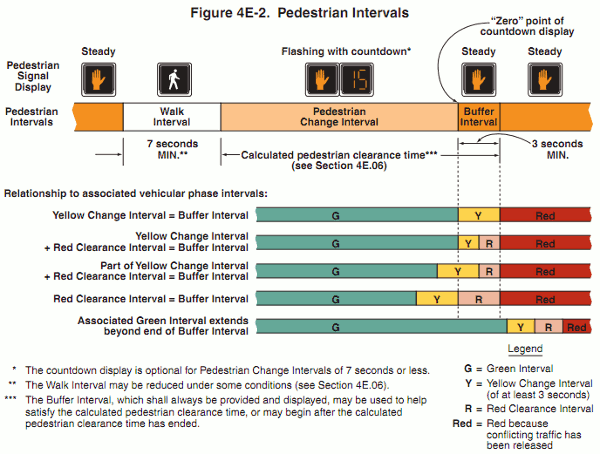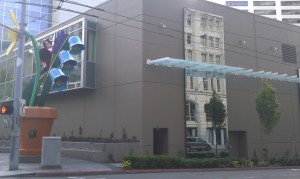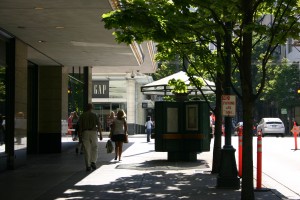Some of Seattle’s pedestrian crosswalk signals do not meet federal guidelines for how much time should be allowed to walk across an intersection safely after the don’t walk signal starts flashing.
The Manual on Uniform Traffic Control Devices (MUTCD) sets standards for municipalities to follow for traffic control devices, including crosswalks. SDOT uses this standard to set the amount of time pedestrians have to clear the intersection once the don’t walk signal starts flashing. This length of time before cross-traffic is allowed to move, called the pedestrian clearance time, should allow enough time for people to clear the intersection before the signal changes.

Pedestrian Intervals from Manual on Uniform Traffic Control Devices
Until 2009, the standard was based on a pedestrian foot speed 4 feet per second, which is what many intersections in Seattle are based on. The latest manual recommends enough time for a pedestrian traveling at 3.5 feet per second (fps) to clear the intersection (section 4E.06).
So, if an intersection takes 10 seconds to cross at 3.5 fps, the current recommendation would allow the flashing signal to start with 6 seconds remaining and then there would be 4 seconds where the don’t walk signal would be up before the cross signal turns green.
However, a survey of several downtown Seattle intersections found that some intersections do not even meat the older, looser standard, giving pedestrians an inadequate amount of time to cross. All crosswalks at 6th and Virginia were found to be significantly out of compliance – to meet the current federal standard, the flashing don’t walk signal at this intersection would need to last for five seconds longer.
Several other intersections are out of compliance with the stricter 2009 standard, including crosswalks across 4th at Stewart and Pine, as well as crosswalks across 5th and 6th along Pine. These intersections are commonly used by tourists, as well as families with children and the elderly, who may move at a slower pace than other pedestrians. In many cases SDOT set the standard pedestrian clearance time not a second more than the previous minimum.
While Washington has not yet adopted this revised standard, “SDOT does plan on using 3.5 fps wherever practical and is doing so with all signal timing changes currently underway,” according to spokesperson Rick Sheridan.
The Federal Highway Administration has set a target compliance date for all signals to be updated by the end of 2014. “At the current pace of signal timing changes, SDOT would not be able to modify all locations” in this timeframe. “This will be raised during the 2012 budget deliberations to determine if additional funds can be added to allow all modifications to be made by the end of 2014,” according to Sheridan.
There is flexibility in the federal standard for SDOT to set their signals at a higher level than the minimum recommended time, so it’s unfortunate that these intersection times are so short. This is a difficult thing to measure, as it’s based on intersection width, but if you find an intersection that you believe does not allow enough time for people to cross, you can report it via SDOT’s Street Maintenance Request Form or by e-mailing traffic.signals@seattle.gov.
A follow-up post has been posted: Should Signal Countdowns Exceed Standard?.







